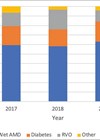
In September 2019, we organised a training course at Great Western NHS Hospital (GWH), Swindon, which provided presentations, discussions and hands-on wet lab experience on how to perform intravitreal injection using intravitreal assisted device (INVITRIA) for nurses and doctors from across the country.
The objective of the course was to use the ‘Swindon Training Model’ to provide the delegates with an objective and structured approach on 12 week nurse injector training pathway, to learn how to perform intravitreal injections safely and efficiently using intravitreal assisted device and guidance on setting up safe and efficient nurse-led intravitreal injection services. During the course, delegate responses on various topics were recorded using the Turning Point® voting pads (Turning Technologies, Ohio, USA) and a delegate feedback form was received at the end of the course.

The wet lab.
The course consisted of the following presentations:
- The path for becoming a nurse injector and competency documentation: This topic was presented by Mrs Angela Exton, a senior staff nurse who has performed more than 6000 intravitreal injections. The presentation included an explanation of the training programme and how to document the progress in training and the final assessment. It also included a highlight on the qualities that are desired in someone who is looking to becoming an injector.
- Introduction to InVitria, cost effectiveness and patient feedback: The second presentation was delivered by Mr Hani Hasan (Speciality Doctor) in which a discussion of the benefits of the InVitria device was presented together with the cost-effectiveness model, safety audit (GWH Medisoft data) and patients’ feedback.
- Tips for becoming a successful injector: Sister Karen Walker presented her experience with administering injections in challenging situations and how to overcome those difficult cases, for example, nervous patients, patients with small eyes and poor positioning, etc.
- How to run a successful intravitreal injection service: Dr Sunil Mamtora presented a video course demonstrating the way in which Swindon delivers a safe and efficient intravitreal injection service including the role of medical retina co-ordinators and virtual clinics.
The course also included a number of video demonstrations of the use of InVitria, the injections process and an overview of the facilities and resources needed to set up the service.
The main theme of the course was to keep the sessions interactive by asking the delegates to vote on various topics and questions that appeared in the presentations throughout the course using the Turning Point® voting pads and also through interactive discussion lead by Mr Nimish Shah (Consultant Ophthalmologist, GWH Swindon).
Delegate responses
All course delegates (n= 22) participated in answering the questions that came up during the course; 86% (19/22) of the delegates were females and 90.9 % (20/22) were nurses, the rest included a GP doctor and a manager.
Only 5.6% of the delegates had ever performed intravitreal injections, so the majority were coming to learn the process for the first time.
In the units where injections were performed, 71.4% were using disposable drapes and speculums, 28.6% were using other methods such as reusable specula but none of the participants reported experience using any assistant devices. The response on average number of injections performed per session / injector at their respective units was as follows: 46.2% (17 or more), 38.5% (13 to 14) and 15.3% (11 to 12).
Those figures were for doctor-led injection clinics; the average number of injections performed by nurses at the Great Western Hospital is 17-18 injections / session / injector.
The most common types of anaesthetic used in the units where our delegates came from are: Proxymetacaine (76.5%), Tetracaine (17.6%) and Oxybuprocaine (5.9%).
We then asked delegates to tell us how much they thought it would take to train a nurse practitioner to perform injections independently, 5.9% responded eight weeks, 29.4% responded 16 weeks and the majority (64.7%) said 12 weeks. The length of the structured training process at the great western hospital is 12 weeks.
In the cost analysis lecture, 90.9% of the delegates agreed that the use of intravitreal assistant devices would reduce the cost of injections. Also, all of our delegates reported that they believe that using intravitreal assistant devices carried no increase to the risk of developing Endophthalmitis a standard procedure.
At the Great Western Hospital, we use Iodine as the standard disinfectant, 100% of the course delegates reported similar practice in their units.

Course group photo.
Delegate feedback
After the candidates had the chance to practise administering intravitreal injections using the InVitria device on mannequin eyes, we obtained feedback from them about their experience. The feedback was aimed to reflect the quick learning curve for using the device and the link between the theoretical and practical parts of the course, which mesh together to provide the practitioner with the confidence needed to perform this skill. Course delegates gave an overall rating of 8.9/10 for the quality of the presentations; 95% of the candidates rated the course content as “excellent” to “very useful”. We aimed to enrich the candidates’ experience by including sessions about dealing with technically challenging patients and the tips and tricks to become a successful injector.
We included a talk about the design and properties of the InVitria device; 75% of the candidates rated that information as “very interesting”, and 20% as “somewhat interesting” respectively. One hundred percent of the delegates indicated that they believe that InVitria will enable them to perform injections safely and efficiently (bearing in mind that some came from non-clinical backgrounds); 95% indicated that they are “very likely to likely” to use InVitria in the future.
Eighty-five percent of the delegates said that they are very likely to recommend our course to their colleagues and 75% gave and “excellent” overall rating.
Conclusion
We have managed to organise this training course with nurses being the main target delegates, but the course is also suitable for junior doctors, trainees along with medical retina consultants and managers who may plan to set up a nurse-led intravitreal injection service. The feedback about the course has been encouraging and we aim to organise another course at Swindon on an annual basis.
If you would like to watch the video from the course, it is available here:
https://www.youtube.com/watch?v=as197vKldAI&t=857s
Declaration of competing interests: None declared.
COMMENTS ARE WELCOME









